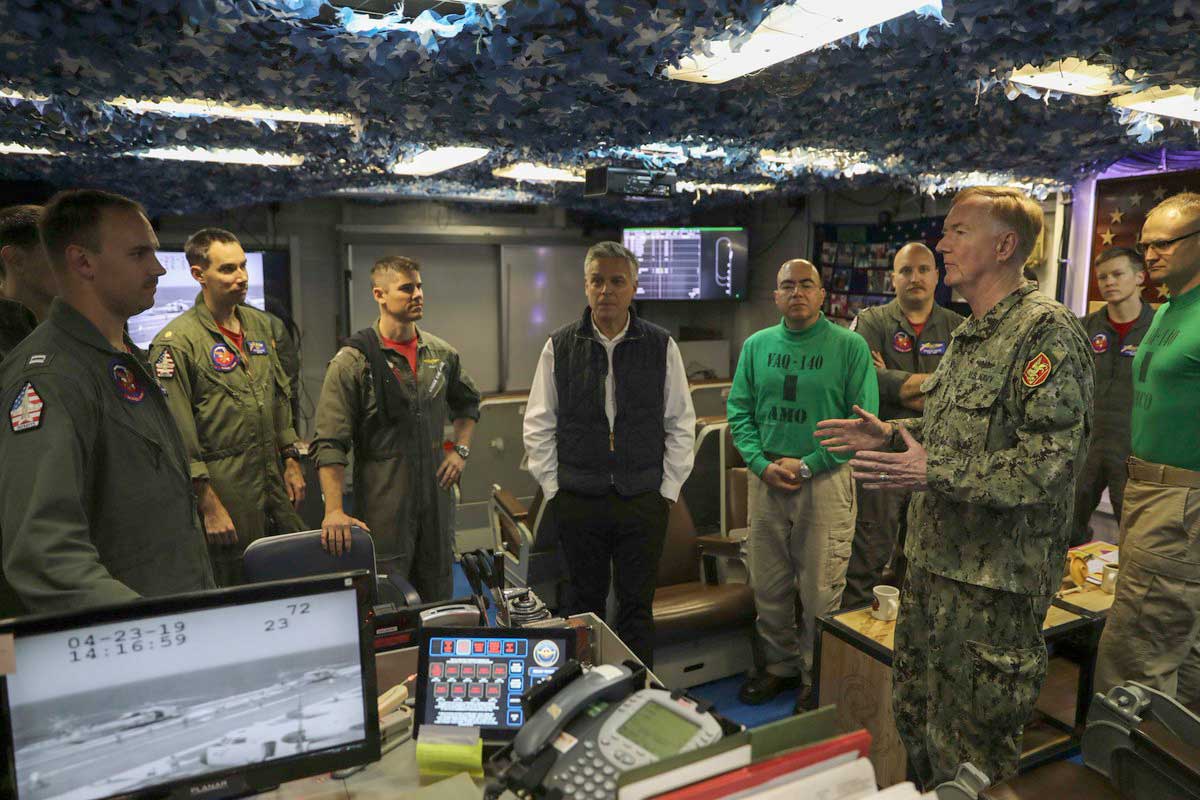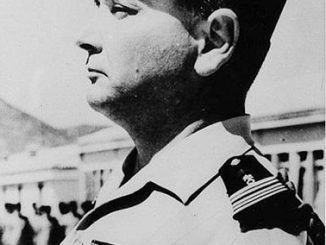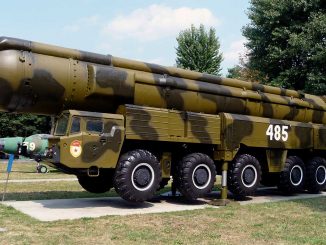John C. Stennis CSG has been working with allies and partners through its deployment to include projecting joint capabilities with maritime forces from the French Charles de Gaulle Carrier Strike Group in the Red Sea.
Mediterranean Sea ─ (NNS) ─ April 23, 2019 ─ U.S. Ambassador to Russia, Jon M. Huntsman Jr. and Adm. James G. Foggo III, commander, U.S. Naval Forces Europe-Africa and Allied Joint Force Command Naples, Italy, observed dual carrier strike group (CSG) operations from the Nimitz-class aircraft carrier USS Abraham Lincoln (CVN 72) in the Mediterranean Sea.
The Abraham Lincoln and John C. Stennis CSGs began dual operations April 23. The CSGs will complete high-end warfighting training as they work multiple scenarios integrating the two air wings and surface ships with key allies and partners in the European theater.
“In the era of great power competition, particularly in the maritime domain, one carrier strike group provides tremendous operational flexibility and agility,” Foggo said. “Two carrier strike groups operating simultaneously, while also integrating and advancing interoperability with our highly capable NATO allies and partners, provides an unprecedented deterrent against unilateral aggression, as well as combined lethality. It also should leave no doubt to our nation’s shared commitment to security and stability in the region.”
In total, the dual CSG operations include more than 130 aircraft, 10 ships and 9,000 Sailors and Marines.
This is the first time two U.S. carriers have operated in the Mediterranean Sea at the same time since the Dwight D. Eisenhower and Harry S. Truman CSGs were deployed to the region in 2016.
“Each of the carriers operating in the Mediterranean at this time represent 100,000 tons of international diplomacy,” Huntsman said. “Diplomatic communication and dialogue coupled with the strong defense these ships provide demonstrate to Russia that if it truly seeks better relations with the United States, it must cease its destabilizing activities around the world.”
While in theater, the CSGs will continue to work with regional allies and partners at sea, creating opportunities for high-end maritime integration and improving collective proficiency and interoperability.
The Spanish Alvaro de Bazan-class frigate ESPS Méndez Núñez (F 104) is integrated with the Abraham Lincoln CSG and operates as one of Lincoln’s escorts during its around-the-world deployment, displaying the United States’ commitment to NATO allies, including the Spanish Navy (la Armada Española).
“The Méndez Núñez steaming alongside USS Abraham Lincoln is a sight to behold,” Foggo said. “Our interoperability with Spain is remarkable.”
John C. Stennis CSG has been working with allies and partners through its deployment to include projecting joint capabilities with maritime forces from the French Charles de Gaulle Carrier Strike Group in the Red Sea.
The Charles de Gaulle CSG, composed of France’s Marine Nationale aircraft carrier FS Charles De Gaulle (R 91), F70AA-class air defense destroyer FS Forbin (D 620), and the Royal Danish Navy Iver Huitfeldt-class frigate HDMS Niels Juel (F 363), along with the John C. Stennis CSG, conducted aircraft training, a low-light gunnery exercise, and a liaison officer exchange program.
While in the European theater, Abraham Lincoln and John C. Stennis CSGs will continue to work alongside NATO allies and partners, increasing interoperability to ensure maritime security and stability.
USS John C. Stennis (CVN 74) deployed from Naval Base Kitsap-Bremerton Oct. 15, 2018 while Abraham Lincoln deployed from Naval Station Norfolk, April 1 this year.
The carriers are in the midst of a homeport shift with Stennis heading to Norfolk, and Lincoln heading to San Diego.
Get more information about the Navy from US Navy facebook or twitter.
For more news from Commander, U.S. Naval Forces Europe and Africa/U.S. 6th Fleet, visit www.navy.mil/local/naveur/.











